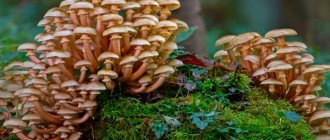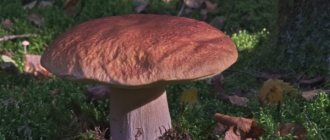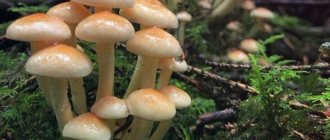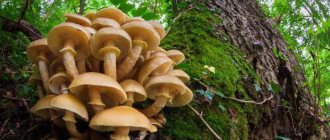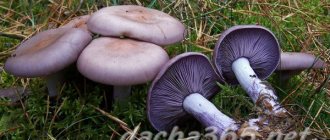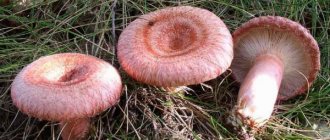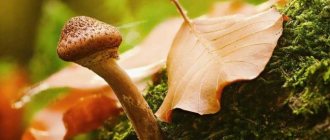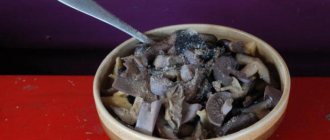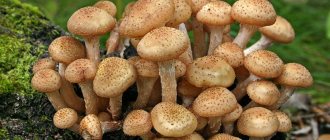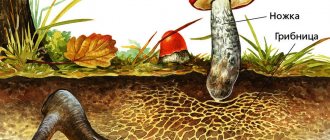Honey mushrooms
Small mushrooms with round caps appear in friendly groups on green meadows or stumps. Fragrant and generous in harvest, honey mushrooms have a delicate taste and are suitable for a variety of mushroom dishes. They are successfully salted, pickled, boiled and roasted. A few small fragrant mushrooms will flavor potato soup or pasta, making the simplest dish original, satisfying and healthy.
Types of mushrooms
There are several species that differ in time and place of growth, as well as taste and appearance.
Autumn honey mushrooms (real) (Armillaria mellea)
Autumn honey mushrooms (Armillaria mellea)
Groups of autumn or true honey mushrooms can be found in late summer and early autumn on stumps and living trees, most often on birch, less often on aspens, maples and other deciduous trees.
This most delicious and aromatic species is quite large and is characterized by a rounded cap with a diameter of 5–12 cm, initially convex and then wide, which becomes smooth, prostrate, and brown in color with age. The young skin is light brown and as if sprinkled with dark scaly crumbs.
The leg is slender, up to 10 cm high, with a typical white ring, the color is light cream at the top and darker at the base. The plates are white, the flesh has a pleasant sourish, slightly tart taste.
Summer honey mushrooms (Kuehneromyces mutabilis)
Summer honey mushrooms (Kuehneromyces mutabilis)
Early small mushrooms with an orange-brown cap and a noticeable watery area in the center appear on trees from the end of May until late autumn. The cap, up to 5 cm in diameter, opens over time and sheds the lower cover. The leg is thin, hollow, up to 6 cm high with a dark ring.
Mushrooms grow together in colonies and sit tightly on damaged wood of deciduous trees. The plates are creamy-brown, the flesh is brownish-red, fragile, with a subtle smell of fresh wood. The fruit body is slightly bitter and can only be used boiled.
Meadow honey mushrooms (Marasmius oreades)
Meadow honey mushrooms (Marasmius oreades)
Flocks of sunny meadow mushrooms appear among meadow grass, on the edges and along forest clearings, starting in May, and disappear by the end of summer. The cap is small, about 3 cm in diameter, with a slight elevation in the center, and the skin is beige-orange. The leg is thin, up to 7 cm high. The plates are creamy, sparse, the flesh is yellowish, with a pleasant sweetish taste.
Colonies often form in the form of circles, leaving an empty bald spot in the center. In the old days, this phenomenon was called witch circles. In fact, the explanation is simple - ripe spores throw out long thin web-like threads in all directions, at the ends of which fruiting bodies rise along the entire circumference. There are few nutrients left in the center of the mushroom clearing, so the grass does not grow there and dries out, forming small round wastelands.
Winter honey mushrooms (Flammulina velutipes)
Winter honey mushrooms (Flammulina velutipes)
Even during winter thaws, under the snow on old poplars or willows, you can find beautiful, even caps of winter mushrooms. They are medium in size, up to 8 cm in diameter, the skin color is ocher-brown, slippery and smooth in damp weather, and glossy in dry weather. The leg is hollow, velvety, about 6 cm high, noticeably darkening towards the base, changing color from light brown at the top to dark brown or burgundy at the bottom. Thin pulp of cream color, neutral taste, with a subtle mushroom aroma, creamy plates, frequent.
Winter mushrooms are good boiled, pickled and in pickles. It’s amazingly pleasant to collect these gifts of nature from under the snow in the cold season. The species is cultivated on an industrial scale and is known under the names "inoki" and "enokitake".
For those who love experiments
Turn growing honey mushrooms into a hobby! It's easy to do this at home.
It is necessary to purchase mycelium, select a substrate, and create certain climatic conditions.
They use jars on window sills, bags in basements, logs in greenhouses - whatever you like. Mushrooms grow tasty and harmless.
Places of distribution and time of collection
In mid-May, summer honey mushrooms ; they are sometimes called spring mushrooms. The species is found until the beginning of September, quite often among humid forests, appearing in large colonies on deciduous wood. It is advisable to collect them by cutting off the caps alone, since the hollow thin stem is hard, fibrous, and has no nutritional value.
meadow honey mushrooms appear singly or even in groups , flashing a warm yellow-brown color among the grass in forest clearings, pastures, along paths and ravines. Harvests can be harvested before the beginning of autumn.
The end of August and the time of the first drizzling rains is the time to collect real or autumn honey mushrooms . It is easier to find them on birch and aspen wood - on stumps and old trees. These perky mushrooms are collected until late autumn. The frost can already silver the grass, but they are still visible on the stumps.
winter honey mushrooms appear , appearing in fused groups on fallen trees and stumps of poplars, willows and maples. Their appearance is a sign of a weakened or old tree. You can find them in forests, parks, old orchards, and artificial plantings. Fruiting bodies are collected not only throughout the fall before the onset of winter and severe frosts, but also during winter thaws, until the arrival of the real May warmth.
Popular message topics
- The nutcracker bird
is a nutcracker bird that lives in taiga-type forests in Europe and Asia, from Scandinavia and the Alps to Kamchatka, the Kuril Islands, Primorye, Japan and China. - Strawberries
are a tasty, sweet, bright and slightly sour berry that is loved by both children and adults. Nowadays it is a fairly common product on the world market. - Socialization of personality Socialization
, as a term, does not have any specific and clear definition in psychology. Everyone is accustomed to the generally accepted definition of this term, as a process of some kind of formation or formation of personality,
False honey mushrooms
Everyone enjoys honey mushrooms - productive, tasty, fragrant mushrooms that can be collected all year round. But there is one significant drawback - the presence of similar species, which at best are classified as conditionally edible, and at worst, poisonous. The danger is aggravated by the fact that some look-alikes are not only very similar, but also grow next to edible mushrooms, literally on the same stump.
Sulphur-yellow honey fungus (Hypholoma fasciculare)
Sulphur-yellow honey fungus (Hypholoma fasciculare)
The most dangerous of the doubles, a very poisonous species. The cap is thin, up to 6 cm in diameter, mustard-yellow in color, reminiscent of sulfur, with a darkening center - brown or burgundy. Young mushrooms have a convex cap, while old mushrooms have a wide-spread cap. The plates are fused with the stalk, yellow-brown, later brown. The leg is hollow, curved, greenish, dark underneath. The pulp is poisonous-bitter, with a disgusting odor, yellowish in color. It is this bitter wormwood taste that prevents serious poisoning.
You can find groups of these mushrooms from the end of June until September, in places where edible species grow. In addition to their poisonous color, bitterness and unpleasant odor, false mushrooms can be distinguished by the color of the spores: the sulfur-yellow false mushroom has greenish spores, the summer mushrooms have brown spores, and the autumn mushrooms have white spores. However, twins grown on coniferous wood may not have spores at all.
A noticeable difference between real honey mushrooms is the presence of a ring or “skirt” - the remnants of a discarded cover, which is not present in false species.
Hypholoma capnoides
Hypholoma capnoides
Appears in small colonies on rotting wood in late summer and early autumn. The cap has a large tubercle in the center, light yellow or cream, up to 6 cm in diameter, covered with whitish flakes along the edge.
The pulp is fragile, thin, whitish-yellow, at first the plates are dirty white, grayish, and become purple with age. The legs are thin, brittle, yellow at the top, brown at the bottom, fused at the base. The species is classified as conditionally edible.
Brick red honey fungus (Hypholoma lateritium)
Brick red honey fungus (Hypholoma lateritium)
The bright mushroom forms large colonies, visible from afar with its red tones. The caps are shiny, reddish-red in color, the light edges are sprinkled with grayish flakes. The pulp is mustard yellow and bitter. Appears in late autumn on the stumps of deciduous trees, most often oak and beech.
The fruit bodies are suitable for consumption, but due to the bitter taste they require boiling twice with changing water.
Watery honey fungus (Psathyrella piluliformis)
Watery honey fungus (Psathyrella piluliformis)
Another name is watery psatirella, and there is no consensus on its use - sometimes the mushroom is considered inedible, and in other cases conditionally edible. The cap is 3–5 cm in diameter, slightly convex or prostrate, with cracked, thinned edges. The skin is glossy, brown, with aging it lightens from the center and becomes creamy; there are flaky remains of a blanket on the edges. The spores are brown-violet.
The pulp is brown in color and has a characteristic watery consistency, neutral taste, sometimes with a slight bitterness, and odorless. The stem is up to 8 cm tall, hollow, often curved, covered in the upper part with a weak powdery coating.
Appears in the autumn months in damp places near trees or on stumps, remains of wood, both deciduous and coniferous. Sometimes it develops in the form of large colonies.
Candoll's honey fungus (Psathyrella candolleana)
Candoll's honey fungus (Psathyrella candolleana)
This mushroom is a close relative of the previous species and is also known as Psatirella Candolla. The cap is slightly convex, then spread, up to 8 cm in diameter, with wrinkles running radially from the center to the edges, drying, becoming white or cream. The skin is brownish in color; in young mushrooms it is covered with scales, which disappear with age. The pulp is thin, brittle, tasteless with a slight mushroom aroma. The spores are brownish-purple.
Psatirella Kandolla grows from late spring to early autumn, in groups on the wood of deciduous trees and near stumps. Its use as food is controversial - the mushroom is considered conditionally edible or inedible. Connoisseurs find it quite tasty when soaked, boiled, and then used for marinades and frying.
All of the listed conditionally edible species are boiled for a long time before consumption, changing the water several times, and only then used for food.
Interesting even for experienced mushroom pickers
Honey mushrooms are real workaholics. They parasitize sick or dead plants, successfully recreate soil balance, saturate it with microelements, and enable other plants to grow.
The peel of the meadow honey fungus heals wounds from cuts and relieves pain from burns.
In ancient times, it was believed that the plantation of these mushrooms indicated a treasure. There is no reliable evidence of this; no one has found the treasure.
Maybe already in ancient times they believed that treasure was valuable to the human body. For over a billion years, people have been eating mushrooms. And you?
Beneficial features
Honey mushrooms are recognized as tasty, aromatic mushrooms and, being productive and affordable, are readily collected by mushroom pickers. The fruiting bodies contain easily digestible proteins, including valuable amino acids. At the same time, they have a low calorie content - only 18–20 kcal per 100 g of finished product and can be successfully used as a source of valuable nutrients when losing weight.
Honey mushrooms are rich in microelements useful for the hematopoietic system - zinc and copper; just 100 g of these mushrooms will satisfy the daily need for these elements. They contain B vitamins, especially a lot of thiamine, and ascorbic acid, which have a positive effect on the immune system and nervous system.
The anti-cancer substance flammulin, which has an inhibitory effect on the development of sarcoma, was discovered in winter mushrooms.
In the tissues of honey fungus, researchers found antibacterial compounds that slow down the development of Staphylococcus aureus and other virulent microorganisms.
Chemical composition
Honey fungus contains proteins, amino acids, myristic, palmitic, stearic, palmitoleic, linoleic acids, omega-6 and omega-9, mono- and disaccharides, fiber, etc.
A wide range of vitamins are also found in the mushroom: beta carotene (0.5 mg), ascorbic acid (11 mg), tocopherol (0.1 mg). B vitamins are especially well represented: thiamine (0.02 mg), riboflavin (0.38 mg), nicotinic acid (10.7 mg), pantothenic acid (1.35 mg), pyridoxine (0.1 mg.), folate (48 mcg.)
Macro- and microelements in the chemical composition of the honey fungus are represented by the following: potassium (400 mg), magnesium (20 mg), calcium (5 mg), iron (0.8 mg), and aluminum (7739 mcg.) , copper (85 mcg.), nickel (47.1 mcg.), phosphorus (45 mg.), sulfur (10 mg.), chlorine (5.7 mg.), chromium (5.5 mcg.), sodium (5 mg.), etc.
Contraindications for use
Honey mushrooms of various types are grown on an industrial scale on wood waste or straw, considered a healthy food product, and in some countries a delicacy.
And yet, consumption is associated with risks for people suffering from inflammatory processes of the stomach and pancreas.
Contraindications for use are diseases of the liver and gallbladder, including its resection.
Improperly prepared, undercooked mushroom dishes without sufficient heat treatment can cause digestive upset and allergic reactions.
Mushroom products should not be included in the diet of children under three years of age, pregnant or lactating women.
How to process
Honey mushrooms, like most mushrooms, are a perishable product and must be processed no later than 24 hours after collection. In the refrigerator, the shelf life of raw honey mushrooms can be extended to three days. Pre-culinary processing consists of the following.
First stage
Honey mushrooms are sorted out and carefully examined, removing forest debris and discarding suspicious, wormy, rotten and moldy specimens.
Second phase
Then the mushrooms are washed. The advantages of honey mushrooms include the fact that there is no need to soak them for a long time beforehand. However, for more thorough cleansing, it is recommended to fill the mushrooms with water for up to half an hour, during which the debris stuck to the fruiting bodies soaks, and various insects and pests that may have been hiding inside the pulp emerge. Then they are washed well, changing the water several times.
The exception is mushrooms intended for drying; they do not need to be washed.
Third stage
Some species, such as yellow-red honey fungus, thick-legged honey mushroom, etc., have a slightly bitter or acrid taste, to remove which honey mushrooms must be boiled first.
Also, in some culinary recipes with autumn honey fungus and related species, you can read that these mushrooms can be used to prepare various dishes without preliminary culinary processing. However, one of the leading mycologists in Russia M.V. Vishnevsky warns that they contain small amounts of toxins that can lead to unwanted painful reactions in the digestive tract. During the boiling process, toxins are destroyed, and mushrooms can be eaten without fear for your health. This requirement applies to all types of products, with the exception of drying and some types of freezing.
Many people are interested in how to cook honey mushrooms. Typically, after boiling, the cooking time is 20-30 minutes.
Recipes for dishes and preparations
Before processing, mushrooms are thoroughly washed and cleaned. In most cases, the legs have no nutritional value (except for autumn mushrooms) and are therefore removed. To successfully wash fragile caps, they are immersed in a colander and repeatedly dipped into a basin of clean water, which is changed as they become dirty.
Pickled autumn mushrooms
For 1 kg of autumn mushrooms take 50 g of salt, 20 g of dill - herbs and seeds, 20 g of onion, allspice and bay leaf to taste.
Mushrooms are poured with boiling salted water and boiled for 20 minutes, and after cooking, drained in a colander. First, pour a thin layer of a mixture of dill with pepper and salt into the prepared container. After cooling, the workpiece is placed in a container in rows 5–6 cm thick, sprinkling each layer with a mixture of salt and spices, as well as finely chopped onions.
The pickles are covered with a piece of cloth on top, pressed down with a circle and a weight, and taken out to a cool place, making sure that the brine completely covers them, which should happen in a few days. The food is ready in two weeks, after which it is stored in the refrigerator.
Frozen honey mushrooms
One of the best ways to preserve the nutritional value of mushrooms for a long time is to freeze them. This is a simple and labor-intensive method that allows you to postpone the cooking process until the winter period, which is free from work. Before freezing, mushrooms are cleaned, washed and dried. Then the workpiece is placed in portioned plastic bags or plastic containers and placed in the freezer.
This frozen product can be stored deep frozen at -18°C until the next harvest. Having taken a portion out of the freezer, they immediately begin cooking without waiting for complete defrosting.
Canned honey mushrooms
Freshly collected caps are suitable for preservation. They are washed and filled with cold water at the rate of 200 g of water per 1 kg of mushrooms. Then cook over low heat until the juice begins to release, after which continue cooking for another half hour, skimming off the foam and stirring frequently. Salt the preparation to taste, add a little citric acid - 1 g per 1 kg of mushrooms.
Bay leaves, black pepper and allspice are placed at the bottom of the jars. The boiling caps are placed in jars and filled with mushroom broth. Preservation is sterilized for at least 40 minutes.
When is the best time to collect
The yield of honey mushrooms depends on weather conditions. They do not tolerate drought well.
The best time is the first half of September with an average daily temperature below 15 degrees. They often bear fruit in several waves of 2-3 weeks.
In cooking
Honey mushrooms belong to categories 3 and 4 of nutritional value. The pulp of most representatives is dense, elastic, and does not fall apart during cooking. The taste and aroma are pronounced, pleasant, mushroom. The use of honey mushrooms in cooking is universal: they are boiled, fried, stewed. They are used for preparing a wide variety of dishes, both as a base and as part of other ingredients.
Autumn honey mushrooms are especially valued among mushroom cooking enthusiasts - they are one of the most delicious lamellar mushrooms, the distinctive feature of which is a slightly sour aroma. Based on this, there are many recipes for honey mushrooms.
Honey mushrooms are used for preparing soups, main courses, roasts, stews, appetizers, and sauces. They serve as a filling for various baked goods: pies, pies, pizza, etc. They performed well as a side dish, in particular with meat. Fragrant honey mushrooms are especially valued for preparing various mushroom sauces, for example, for spaghetti, as well as omelettes. Spicy and marinated appetizers with these mushrooms are wonderful. And, of course, honey mushrooms fried with onions and potatoes is a widely known, simple, but beloved dish by many.
Literature:
Beskorovainy A. Mushrooms. Illustrated reference book.
Jansen P. All about mushrooms.
T.A. Ilyina. Mushrooms. Atlas-determinant.
M.V. Vishnevsky. Mushrooms. Key to mushrooms of Russian forests and fields.
Lagutina T.V. The complete encyclopedia of mushrooms.
Mikhail Vishnevsky. Medicinal mushrooms. Great encyclopedia.
Yu.I. Smirnyakov, A.K. Koshcheev. Mushroom picker's companion.
A.P. Umeltsev. Encyclopedia of mushroom picker.
Polenov A.B. Mushrooms. Edible and inedible.
Aurel Dermek. Mushrooms.
N. Goncharova. Mushrooms. To help mushroom pickers.
Subscribe to our official Instagram account. There are many photos of honey mushrooms and other mushrooms here.
View this post on Instagram
A post shared by Sergey Slepnev (@sgribnik71)
How to store
Honey mushrooms are quite versatile mushrooms and have proven themselves well in all types of preparations; they are also tasty when preserved, both as a single component and as part of various vegetable stews.
There are quite a few ways to prepare honey mushrooms and they are very diverse. The least troublesome way to preserve collected mushrooms for use out of season is by drying, in which you do not need to pre-soak and wash them; just clean them of debris with a sponge or toothbrush. In order for honey mushrooms to dry evenly, fruiting bodies are selected of the same size, large honey mushrooms are cut, strung on a thread and dried in the open air. You can also use an oven, stove or electric dryer for drying. With this method, mushrooms retain a maximum of useful substances in their composition.
The hard legs of older honey mushrooms are also suitable for preparations. They are dried in any convenient way, and then ground into powder, which retains a distinct, pleasant, mushroom taste and aroma. Honey mushroom powder is used as an aromatic seasoning in the preparation of soups, sauces, and main courses.
Another convenient way to preserve mushrooms for the winter is freezing, for which both fresh mushrooms and boiled or fried mushrooms are suitable. Fresh mushrooms intended for freezing should first be washed and dried. As a result, you get a ready-to-use semi-finished product - there is no need to defrost the mushrooms, you can start cooking right away. Honey mushrooms in this form do not lose their beneficial properties.
Information! Frozen honey mushrooms are a semi-finished product, ready directly for basic culinary processing.
Of course, one of the most favorite preparations for many people for preparing honey mushrooms for the winter is pickling. Even the harsh legs of pickled mushrooms are particularly attractive, and the marinade gives them a unique piquant taste and aroma. For this type of preparation, you should select young and neat fruiting bodies with a cap diameter of no more than 2.5 cm. Mushrooms are also tasty when salted. Honey mushrooms, both salted and pickled, are also canned.
Important! Please note that not all types can be salted and cold pickled. Autumn mushrooms, thick-legged honey mushrooms, shriveling mushrooms and some others must be subjected to mandatory preliminary boiling in order to avoid poisoning.
